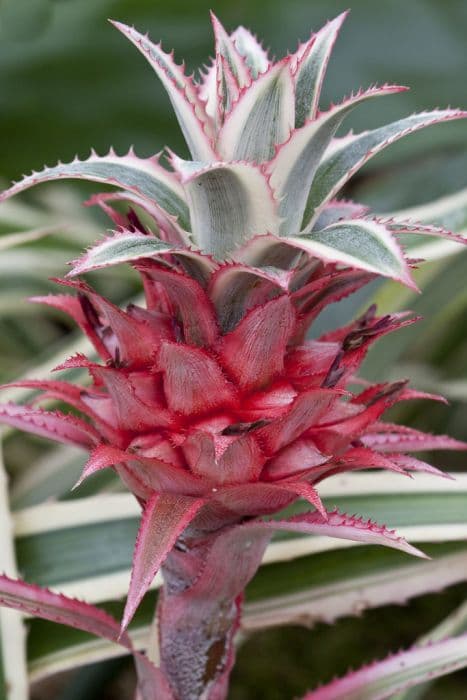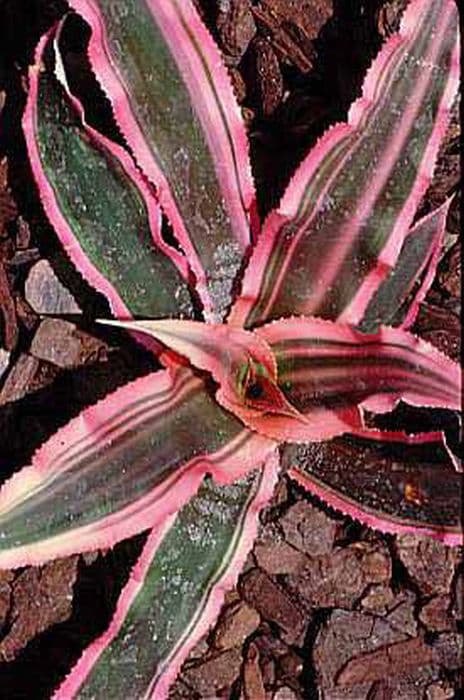Chilean Puya Puya chilensis

ABOUT
The Puya chilensis, also known as the Chilean Puya or Sheep-eating Plant, is a remarkable and striking plant. It boasts a dense rosette of tough, spiny, gray-green leaves. These leaves have a sword-like shape and can be quite stiff and sharp, which helps the plant in deterring herbivores. The edges of the leaves are typically lined with hooked spines, giving it a formidable appearance. The real showstopper is its impressive flower spike. This towering inflorescence emerges from the center of the plant, stretching skywards and providing a visual spectacle. The flowers themselves are usually a vibrant greenish-yellow color, though they can also display shades of metallic turquoise, and they contrast beautifully against the stiff, silvery foliage. The Chilean Puya is known for its adaptation to dry environments, and this is evident in its overall morphology which is designed to minimize water loss. Its leaves often have a waxy or hairy coating that helps in water conservation. This impressive plant provides not just aesthetic appeal with its otherworldly appearance but also serves as an ecological centerpiece in its native environment.
About this plant
 Names
NamesFamily
Bromeliaceae
Synonyms
Chilean Puya, Sheep-eating Plant
Common names
Pourretia coarctata, Puya coarctata.
 Toxicity
ToxicityTo humans
Puya chilensis, commonly known as the Sheeps-eating plant, is not reported to be toxic to humans. There is no significant record of poisoning or harmful effects from ingesting this plant. However, it is worth noting that the physical structure of the plant, with its sharp spines and edges, can cause physical injury if not handled carefully.
To pets
Puya chilensis, known as the Sheeps-eating plant, does not have a reputation for being toxic to pets. It is not listed as a plant that is commonly known to poison animals. Nevertheless, its spiny foliage can lead to physical injuries for pets who might try to chew on or brush against the plant. Owners should keep pets away from the plant to prevent any such injuries.
 Characteristics
CharacteristicsLife cycle
Perennials
Foliage type
Evergreen
Color of leaves
Green
Flower color
Greenish-yellow
Height
10 feet [3 meters]
Spread
6 feet [1.8 meters]
Plant type
Shrub
Hardiness zones
8
Native area
Chile
Benefits
 General Benefits
General Benefits- Ecological contribution: Puya chilensis plays a role in its native ecosystem by providing nectar to hummingbirds and other pollinators.
- Drought resistance: This plant is highly adapted to dry environments, making it suitable for xeriscaping and reducing the need for irrigation.
- Ornamental value: With its striking flower spikes and rosettes of tough, spiny leaves, Puya chilensis is a unique and dramatic addition to gardens.
- Erosion control: The robust root system of Puya chilensis helps stabilize soil on slopes, preventing soil erosion in its native habitat.
- Cultural significance: It has traditional importance in its native regions and can be used in landscape designs to reflect the natural flora of those areas.
- Wildlife habitat: It offers shelter and food for various animals, contributing to biodiversity in gardens and natural settings.
- Low maintenance: Puya chilensis requires minimal care once established, making it an easy plant to maintain for gardeners of all skill levels.
 Medical Properties
Medical PropertiesThis plant is not used for medical purposes.
 Air-purifying Qualities
Air-purifying QualitiesThis plant is not specifically known for air purifying qualities.
 Other Uses
Other Uses- The sharp spines of the Puya chilensis trap small animals, which eventually die and decay at the base of the plant, providing it with essential nutrients.
- Local communities sometimes use the fibers from the leaves of the Puya chilensis to create durable textiles and handicrafts.
- The flowering stalks of Puya chilensis can be used as natural wood substitutes in rural construction for support beams and fencing.
- In g ardening and landscaping, Puya chilensis is often used as a statement plant because of its large size and dramatic appearance.
- Due to its resilience and low water needs, Puya chilensis is utilized in xeriscaping, helping to conserve water in arid environments.
- Some communities use the Puya chilensis as a living fence or barrier due to its thick, spiny foliage which deters animals and intruders.
- The plant is used in education for botanical studies to demonstrate adaptations of plants in arid environments.
- Puya chilensis plays a role in its ecosystem as a source of food and refuge for certain bird species which are adapted to navigate among its spines.
- The flowers of the Puya chilensis can be used as a source of natural dye for coloring textiles with shades of green and blue.
- In some cultures, the presence of Puya chilensis is associated with protection and is thought to keep negative energies at bay.
Interesting Facts
 Feng Shui
Feng ShuiThe Puya chilensis is not used in Feng Shui practice.
 Zodiac Sign Compitability
Zodiac Sign CompitabilityThe Puya chilensis is not used in astrology practice.
 Plant Symbolism
Plant Symbolism- Resilience: Puya chilensis, commonly known as the Chilean Puya, often grows in harsh, arid environments, symbolizing the ability to withstand tough conditions and adversity.
- Self-Sufficiency: This plant is adapted to acquire nutrients in poor soil, which can represent an independent nature and the capacity to thrive with minimal external support.
- Rarity: As a lesser-known plant with unique characteristics, the Chilean Puya can symbolize uniqueness and the value of rare traits or features.
- Protection: The Chilean Puya has sharp spines that deter herbivores, symbolizing defense and the need to guard oneself from external threats.
- Endurance: With a long growth cycle before blooming, this plant represents patience and the reward of endurance, as it can take years to see the spectacular flowers it produces.
 Water
WaterThe Sheep-eating Plant needs to be watered roughly every one to two weeks, allowing the soil to dry out slightly between waterings. When you do water, provide a thorough soaking so that water reaches the entire root system. This plant may need more frequent watering during hot, dry periods, possibly as often as once a week. However, during cooler or more humid times, you might cut back to every other week. Use enough water to ensure the soil is moist to a depth of several inches, which may translate to approximately 1-2 gallons depending on the size of your plant and the environmental conditions.
 Light
LightThe Sheep-eating Plant thrives best in full sun conditions and should be placed in a spot where it will receive direct sunlight for most of the day. This plant is native to the Chilean Andes, so it is accustomed to bright, unfiltered sunlight. Avoid placing it in a location that is subject to prolonged periods of shade or indirect light to mimic its natural habitat.
 Temperature
TemperatureThe Sheep-eating Plant prefers a temperate range and can handle temperatures from about 20°F to 90°F. However, the ideal conditions for the plant are between 70°F and 80°F. Avoid exposing the plant to temperatures below 20°F as this could damage the plant.
 Pruning
PruningPruning the Sheep-eating Plant is done primarily to remove dead or damaged leaves and to maintain its shape. It is advisable to prune at the end of the blooming cycle or in the late winter to keep the plant healthy and prevent it from becoming too large for its space. Prune every couple of years or as needed when you see parts of the plant that require removal.
 Cleaning
CleaningAs needed
 Soil
SoilThe best soil mix for Puya chilensis, commonly known as Chilean Puya, should be well-draining with a mix of sand, peat, and perlite or pumice to mimic its native gritty conditions. The soil pH should be slightly acidic to neutral, ranging from 6.0 to 7.5.
 Repotting
RepottingChilean Puya should be repotted every few years as it grows slowly. It's best to repot this plant when it has outgrown its current pot or the soil has degraded, approximately every 2 to 4 years.
 Humidity & Misting
Humidity & MistingChilean Puya prefers moderate humidity levels but is quite tolerant of dry conditions. It does not require high humidity, aligning with the arid habitats it naturally thrives in.
 Suitable locations
Suitable locationsIndoor
Plant in a well-draining mix with bright light indoors.
Outdoor
Needs full sun, well-draining soil, and space to grow.
Hardiness zone
8-11 USDA
 Life cycle
Life cycleThe life cycle of Puya chilensis, commonly known as the Chilean Puya, begins with seed germination, which is dependent on well-drained soil and warm temperatures. Seedlings develop rosettes of tough, spiny leaves that are silvery-green in color, and these rosettes expand gradually over several years. As a slow-growing plant, Puya chilensis may not flower for many years, often taking between 6–10 years in cultivation to reach maturity. When mature, the plant sends up a large, dramatic flowering spike that can reach 2 meters or more in height, sporting numerous greenish-yellow flowers with striking orange or red stamens that are pollinated by birds, particularly hummingbirds. Post pollination, flowers develop into seed capsules that dry and release seeds, completing the reproductive cycle. After flowering, which can last for several weeks, the individual rosette that has flowered typically dies, but new rosettes formed at the base ensure the continuation of the plant's life cycle.
 Propogation
PropogationPropogation time
Spring to Summer
Propogation: The popular method for propagating the Puya chilensis, commonly known as the Chilean Pineapple Plant, is by seed. The best propagation time for this plant is generally in the spring when temperatures are consistently warm, which is conducive to germination. To propagate by seed, clean seeds should be sown in a well-draining soil mixture, lightly covered with soil, and kept moist but not waterlogged. It is also beneficial to maintain a temperature around 70 to 75 degrees Fahrenheit (21 to 24 degrees Celsius) to encourage germination. Germination can be slow, and it may take several weeks to a few months for seeds to sprout. Once the seedlings have developed a few sets of true leaves, they can be carefully transplanted into individual pots to continue growing until they are ready to be placed in their permanent location.









